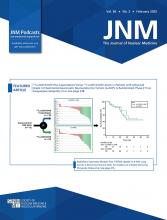TO THE EDITOR: We write in response to the letter from Biegon et al. (1), which critiques our study (2). We provide evidence supporting our study and address factual inaccuracies presented in the letter.
REVIEW OF PREVIOUS STUDIES
Biegon et al. claim that our data are flawed on the basis of their assertion that “attempts to measure [estrogen receptors] in the above-mentioned regions (all besides the pituitary and, in one case, hypothalamus) in human (or rodent) brain in vivo have been unsuccessful (3–7).” (1). This claim is unsupported by the cited studies:
The only research study on humans (3), using a tumor-optimized PET protocol, examined exclusively the pituitary, reporting nonsignificantly higher 18F-fluoroestradiol (FES) uptake in postmenopausal than premenopausal ER-positive breast cancer patients. Also in that study, ovariectomized rats exhibited higher pituitary uptake than did controls.
Two of the studies they cited (4,5) are not research articles. One (4) is a 2018 review noting the absence of brain 18F-FES studies on humans. The single 18F-FES image included—noting pituitary and nonspecific white matter uptake—pertains to a phase 1 trial of RAD1901 (a selective ER degrader), not an inhibition study using estradiol or congeners, as the letter suggests. The other (5) is an “Image of the Month” report cautioning against mistaking pituitary or white matter uptake for metastasis in cancer studies.
Two of the other studies (6,7) are on rats, reporting…
○ “The greatest accumulation of activity was detected in pituitary gland, whereas intermediate levels were found in the hypothalamus; in the remaining areas (striatum, cortex, and hippocampus) the radioactivity concentration was low.” (6).
○ “The highest levels of uptake of 18F-FES were found…in the pituitary, hypothalamus, bed nucleus of the stria terminalis, and amygdala. Other brain regions showed low levels of brain uptake.” (7).
Both of these studies thus report the highest uptake in pituitary and low (but not absent) uptake in cortical, limbic, and other regions, consistent with our findings. Additionally, one of the studies (7) states, “uptake of 18F-FES is not limited by the blood-brain-barrier,” contrary to the letter’s assertion that “the tracer is only useful…in the pituitary, which lies outside the blood–brain barrier.” (1).
17β-estradiol coinjection was associated with lower uptake in the pituitary and hypothalamus in both studies and yielded mixed results in low-uptake areas, showing null (6) or significant differences in some regions (7). Both analyses were conducted ex vivo and limited by small samples of no more than 4 rats per group. Nonetheless, these results are not generalizable to humans. Unlike rats, humans express sex hormone–binding globulin, which protects 18F-FES from rapid clearance. In rats, “low levels of brain uptake of 18F-FES…can be related to the low levels of intact 18F-FES in plasma” (7).
Overall, prior human studies exclusively examined the pituitary, whereas rodent studies reported in vivo uptake in additional regions. Furthermore, our study differs fundamentally from prior literature: it was a systematic 18F-FES PET investigation on healthy midlife women across menopausal stages, using a brain-dedicated protocol, kinetic modeling, and MRI coregistration. These methodologic differences render comparable results unattainable.
CLAIMS OF NONSPECIFIC BINDING
The letter asserts that our findings reflect nonspecific white matter binding, rather than ER density, based on the aforementioned literature and the labeling in Figure 1B in our study. Although we acknowledge that some label-connecting lines are misaligned, appearing closer to white matter, and are receptive to editing the figure, the claim fails to account for several key points:
The lines in Figure 1B point to the general anatomy of interest rather than identifying the tissue boundaries on which regions of interest were placed. Sampling was conducted using standardized regions of interest (8) implemented in PMOD 4.304, with placement confirmed by visual inspection (images available on request). For example, the posterior cingulate region of interest was gray matter–based and distinct from nearby corpus callosum. Further, Figure 1B shows SUVs, whereas analyses were based on distribution volume ratios derived from graphic Logan plots with a valid reference region.
The central finding of our study—that brain ER density varies by menopause status (postmenopausal > perimenopausal > premenopausal)—is not considered in the critique. These results cannot be explained by nonspecific binding, which is independent of menopause status or ER expression. If nonspecific binding were the primary factor, the sampled signal would be uniform across groups, confounding rather than generating group differences. Additionally, our results align with both mechanistic findings that ERs rebound after the early phase of the menopause transition (9) and in vivo evidence of regionally higher 18F-FES uptake in ovariectomized rats (3,7).
Group differences in pituitary signal, acknowledged as specific in the letter, contradict the claim of “No In Vivo Brain Estrogen Receptor Density…”
CONCLUSION
The literature and critiques presented by Biegon et al. do not substantiate the assertion that 18F-FES is categorically ineffective for measuring brain ERs in healthy midlife women. Lastly, we appropriately positioned our findings as preliminary and hypothesis-generating, acknowledging the limitations of 18F-FES and advocating for tracers with higher signal-to-noise ratios.
DISCLOSURE
No potential conflict of interest relevant to this article was reported.
Lisa Mosconi*, Matilde Nerattini, Valentina Berti, Dawn C. Matthews, Caroline Andy, Schantel Williams, Matthew Fink, Alberto Pupi, Roberta Diaz Brinton
*Weill Cornell Medicine New York, New York
E-mail: lim2035{at}med.cornell.edu
Footnotes
Published online Jan. 8, 2025.
- © 2025 by the Society of Nuclear Medicine and Molecular Imaging.
REFERENCES
- Received for publication December 4, 2024.
- Accepted for publication December 10, 2024.







